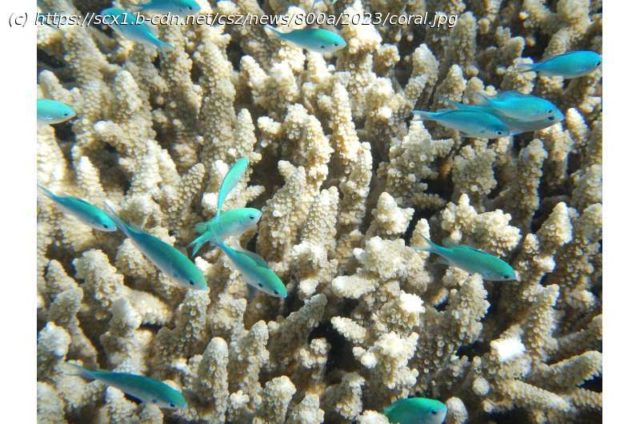Three and a half miles off the Florida Keys, Kylie Smith kicked to the surface of the ocean, then looked back down through her scuba mask to confirm what she had seen in the coral reef 15 feet below.
Three and a half miles off the Florida Keys, Kylie Smith kicked to the surface of the ocean, then looked back down through her scuba mask to confirm what she had seen in the coral reef 15 feet below.
A colony of baby elkhorn coral was bone white. Another grouping of the animals was dying from rapid tissue loss disease. Smith’s team of volunteers had planted the baby coral in the last year and watched them thrive. Now both colonies—which had slowly spread, with tiny nubs reaching toward filtering sunlight—were being damaged as water temperatures spiked.
“It’s heartbreaking,” the 34-year-old coral ecologist said softly, cupping her hands around her scuba mask as she bobbed in the waves above Alligator Reef.
As ocean temperatures rise to historic levels for July—a buoy in the shallow Florida Bay recently registered 101.1 degrees at the surface—corals are bleaching along Florida’s fragile 350-mile-long barrier reef.
At the bottom of some of the reefs that make up the barrier system, the only one in the contiguous United States, temperatures have reached 93 degrees, more than 6 degrees higher than is average for the time of year. Without major human intervention, some species of the ancient marine animals, vital to thousands of species of sea life and the region’s economy, risk extinction.
Up and down the coast, divers are scrambling to monitor corals—some recently planted on the ocean floor, others that have thrived for thousands of years. A network of scientists and coral restoration experts is also racing in a modern-day Noah’s Ark-style mission to haul specimens to safety before they perish. Some are afraid to open their eyes when they near the bottom.
Smith, a co-founder of I-CARE, a group that trains and organizes recreational divers to plant corals that have been raised in nurseries, has already mourned the death of one of her prize specimens: an elkhorn that had fused together from several pieces little bigger than a quarter to form crowns branching up to 10 inches.
But Smith, who got certified as a diver at 15 to overcome her early terror of watching “Jaws,” was not dwelling on her losses. Her group has planted 14,684 corals in the reefs along Florida’s Upper Keys in the last 2½ years, more than a quarter here in Alligator Reef, and she had more to check on.
“Let’s go see if we can find a happy one!” she said, kicking her fins and fluttering back down.
She neared what had been a promising colony of knobby brain coral, tiny and dome-shaped with undulating ridges. Smith circled the coral, which had been cared for in a nursery for two years and had been doing well since being transplanted in May. Now it was light and paling.
But a few feet deeper, she spotted a brain coral that was a healthy, greenish brown. Then, another cluster planted in May that was a little pale, but already starting to fuse.
Smith wasn’t sure what accounted for the variation in the slow-growing species. Maybe it was the deeper water. Maybe the corals that retained their color were more resistant to heat stress.
She swam on—past a turtle scratching its back near a cluster of completely bleached elkhorn—in search of corals that showed signs of resilience.
Protecting and restoring the corals of Florida’s degraded barrier reefs is no easy task.
In the last four decades, this intricate stretch of shallow reef formations that came into existence around the last Ice Age has lost about 98% of its corals from a combination of polluted water, disease, abnormal ocean temperatures, overfishing and other human impacts.
Seven species of the coral found in Florida’s reef—elkhorn, staghorn, boulder star, mountainous star, lobed star, rough cactus and pillar—are listed as threatened under the Endangered Species Act.
This is not the first time corals in the Florida Keys have endured bleaching. When the water gets too hot, the tiny symbiotic algae that live in the corals’ tissues, zooxanthellae, turn excess energy from sunlight into dangerous toxins. The corals then expel the algae, their primary food source. Without the algae, corals turn white and are more susceptible to disease. Though corals can survive for a few days or weeks without the algae, they are less likely to recover from longer stretches of heat.
Mass coral reef bleaching events have risen steadily across the world in the last 40 years. A recent study found the annual risk of bleaching increased from 8% in the 1980s to 31% in 2016. In Florida, bleaching in the summer of 2014 harmed or destroyed a third of elkhorn corals at federal monitoring sites across the Upper Keys. What worries scientists now is that bleaching began in July—and August and September are typically the hottest months.
Last month, scientists with the National Oceanic and Atmospheric Administration raised their coral bleaching warning system for the Florida Keys to its highest heat stress level, warning of a 90% probability of bleaching through October.
Americans who have never gotten close to a coral on the bottom of the ocean might be surprised to find how much their lives are linked to the tiny marine invertebrates that form colonies and secrete calcium carbonate to form a hard skeleton.






